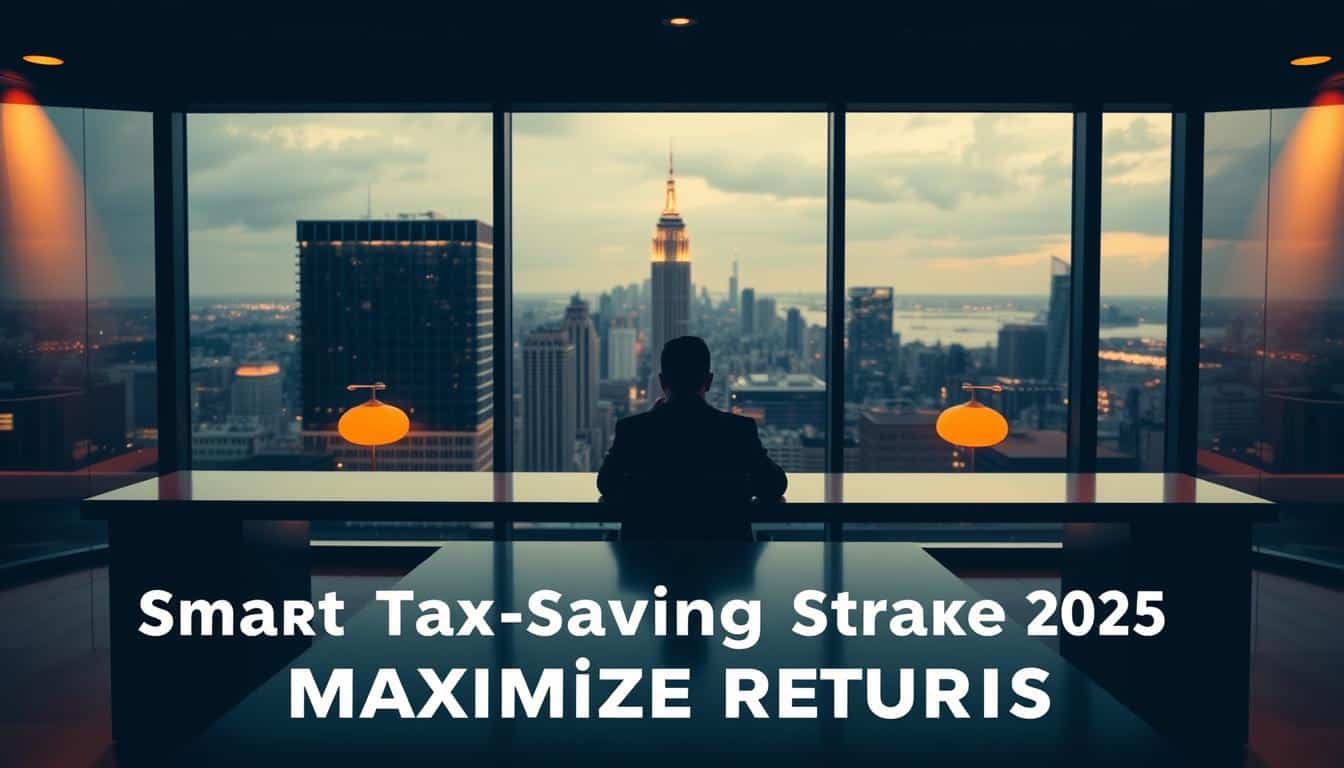This piece offers smart ways for US savers to grow their money. It’s great for both experienced savers and new investors. We talk about various investment options. These include cash choices, retirement funds, low-cost index funds, ETFs, and more.
Anúncios
We’re keeping things friendly and easy to understand. You’ll learn how to boost your savings. This includes reviewing costs and risks. We also touch on tax strategies that matter to US investors. Look for tips on 401(k) matches and safe bank choices.
We’ve put everything into ten short sections. We start with why investing is key. Then, we cover cash, retirement accounts, and passive stocks. We also talk about earning from investments, buying real estate, considering other assets, and making a plan. Each part gives you tips to decide what’s best for you.
Anúncios
Key Takeaways
- Investment ideas here focus on practical ways to maximize savings for US investors.
- Coverage includes cash equivalents, retirement accounts, ETFs, dividend stocks, real estate, and alternatives.
- Actionable comparisons and tax-aware tips help savers choose based on cost, liquidity, and risk.
- Resources reference reputable providers like Vanguard, Fidelity, Charles Schwab, and FDIC-insured banks.
- The guide is written for savvy savers and beginners ready to move cash toward long-term growth.
Why Savvy Savers Should Prioritize Smart Investment Ideas
Smart savers understand that holding onto cash is good for immediate needs and emergencies. However, it’s different from seeking profits. Saving focuses on keeping your money safe and easily accessible. For savings, people often use FDIC-insured accounts for emergency funds and short-term objectives.
Investing is about putting money into assets like stocks, bonds, and real estate to gain more over time. This choice trades easy access to your money for the chance to beat inflation. Deciding how to balance accessibility, returns, and risks is crucial in choosing between saving and investing.
The difference between saving and investing
Saving keeps your money’s value for the short term. It’s best used for covering 3 to 6 months of expenses and immediate needs. FDIC-insured accounts and similar options are great for this purpose.
Investing aims for growth. Over time, broad stock market indices like the S&P 500 tend to outdo cash and bonds. By accepting short-term fluctuations, investors can enjoy compounding growth and build more wealth.
How investing accelerates wealth accumulation
Compound returns can significantly grow your savings over time. Stocks have historically offered higher yearly returns than cash. This advantage helps savers outsmart inflation and increase their wealth.
Regular saving and careful investing are keys to long-term financial success. In the US, using tax-advantaged accounts like 401(k)s and IRAs can boost your savings by keeping them tax-free.
Risk tolerance and time horizon considerations for US investors
You should evaluate your risk tolerance by considering both your ability and willingness to handle risks. Your income, savings for emergencies, and financial duties affect your capacity. How comfortable you feel with market ups and downs shows your willingness.
Align your investments with your time frame. If you’re planning for the short term, choose safer investments to keep your capital safe. For longer goals, you might prefer stocks for their potential to greatly increase your wealth.
US investors also need to think about their retirement plans, Social Security benefits, tax situations, and how much they need in an emergency fund. Set your financial strategy by matching your goals, timelines, and how much risk you can handle.
High-Yield Savings and Cash-Equivalent Options
Looking for a safe spot for your short-term money? Cash equivalents are predictable and easy to get to. They include online high-yield savings, money market accounts, short-term CDs. Pick one by comparing APYs and understanding how quickly you can access your money.
Online banks like Ally Bank and Marcus by Goldman Sachs offer great rates. Even regional online banks can have deals as good or better. To pick the best, look at more than just the big rates. You need to check how often interest is added, any fees, and the smallest amount you can have in there. Remember, the FDIC makes sure your money is safe up to $250,000 at each bank.
Online high-yield savings accounts and how to compare APYs
APY tells you what you’ll really earn in a year after interest is added. Just looking at the rate isn’t enough because how often interest is added can vary. Make sure to look at any monthly fees and how much money you need to keep in your account as these can eat into what you earn.
- Compare compounding (daily vs. monthly)
- Verify minimum balance rules
- Confirm fee schedules that can reduce your APY
Money market accounts and short-term CDs for liquidity
Money market accounts give a decent return and let you write checks or use a debit card. But money market funds at brokerages aren’t covered by the FDIC, even though they’re made to be stable.
Short-term CDs lock in a rate but for a certain time. Spreading investments in CDs of 3, 6, and 12 months can give you both good returns and flexibility. Just make sure you know the cost of taking your money out early.
| Product | Typical Benefit | Risk/Consideration | Best Use |
|---|---|---|---|
| High-yield savings (online banks) | Higher APY with FDIC insurance | Rates can change; watch fees | Emergency fund and short-term goals |
| Money market accounts (banks) | Liquidity with check/debit access | Lower yields than some CDs | Cash buffer and bill payments |
| Money market funds (brokerages) | Potentially competitive yield | Not FDIC-insured; market-based | Large brokerage cash sweep options |
| Short-term CDs | Locked higher rates for term | Early withdrawal penalties reduce liquidity | Laddered income and rate protection |
When cash equivalents make sense in a diversified plan
Cash equivalents are perfect for emergency funds, soon-to-be-needed tuition, or down payments. They keep your money safe and let you get to it quick. Use them for unsure times or when you have to pay for something soon.
Have enough in cash to handle what’s coming up soon but put long-term savings into things that earn more. Doing this beats inflation and keeps your money ready for big costs.
Retirement Accounts and Tax-Advantaged Strategies
Choosing the right retirement accounts is crucial. This section offers steps for employees and self-employed savers. You’ll find tips on how to contribute, get tax benefits, and use strategies to save and reduce taxes over time.

401(k) fundamentals and practical steps
A 401(k) lowers your taxable income by using pre-tax money. Many offer an employer match, which helps your savings grow. Automatic enrollment and target-date funds simplify saving for workers.
To make the most of it, always contribute enough to get the full employer match. After getting a raise, use auto-escalation to increase what you put in. Choose low-cost options from Vanguard or Fidelity to keep fees low and improve your returns.
Comparing tax treatment for IRAs
Traditional IRA contributions might lower your taxes now. You’ll pay taxes on withdrawals in retirement. Roth IRAs use money you’ve already paid taxes on. This means you won’t pay taxes when you withdraw.
Pick a Traditional IRA if you think you’ll be in a lower tax bracket when you retire. Go with a Roth IRA for tax-free growth and if you think your taxes will be higher later. Keep an eye on IRS rules about how much you can contribute and income limits for Roths.
Advanced strategies for high earners and small business owners
The Backdoor Roth is for high earners who want Roth IRA benefits. It involves making contributions to a Traditional IRA, then converting them. Make sure to keep good records because of IRS rules.
If you’re self-employed, consider a SEP IRA or Solo 401(k) to put away more money. The SEP IRA is easy to set up for small businesses. A Solo 401(k) lets owners make both employee and employer contributions for bigger savings.
| Account | Tax Treatment | Best Use Case | Key Limit/Note |
|---|---|---|---|
| 401(k) | Pre-tax contributions | Employer plans with match | Capture full employer match; consider target-date funds |
| Traditional IRA | Pre-tax or tax-deductible | Lower current taxes; RMDs apply | Deductibility depends on income and plan coverage |
| Roth IRA | After-tax, tax-free growth | Tax-free retirement income | Income phase-outs limit direct contributions |
| Backdoor Roth | Conversion to Roth | High earners seeking Roth benefits | Watch pro-rata rule and conversion timing |
| SEP IRA | Employer contributions, tax-deferred | Self-employed or small business owners | Higher contribution limits; simple setup |
| Solo 401(k) | Employee + employer contributions | Owner-only businesses seeking large savings | Allows higher combined contributions than SEP IRA |
Retirement planning is complex due to many IRS rules and limits. It’s wise to talk to a CPA or financial advisor. They can help choose the best accounts for your tax situation and retirement goals.
Low-Cost Index Funds and ETFs for Long-Term Growth
Passive investing helps you reach broad markets with minimal fees. Firms like Vanguard, Fidelity, and Charles Schwab have options like VTI, VTSAX, FXAIX, FZROX, and SCHB. These options keep costs low and follow the market closely.
Small differences in expense ratios can matter a lot over time. For example, a fund with a 0.03% expense ratio can save you more than one with a 0.50% charge. Over many years, this can mean saving thousands of dollars.
The core-satellite approach mixes sturdy investments with chance. Use index funds or ETFs as your main investment. Then, add smaller, targeted investments to try for bigger growth. This keeps costs low while giving room for special investments.
For a basic mix, choose a big U.S. equity fund, an international fund, and a bond fund. Vanguard Total Stock Market, Vanguard Total International Stock, and Vanguard Total Bond Market are good picks. Adjust the mix based on how much risk you like. More risk could mean more stocks than bonds, and less risk the opposite.
Rebalancing keeps your investments in check. Look at your mix every year or if things shift too much. Put bonds in tax-saving accounts, and keep index funds and ETFs in regular ones to lower taxes.
Quick reference for common builds:
| Investor Type | Typical Allocation | Core Funds (Examples) | Notes |
|---|---|---|---|
| Aggressive | 80% equities / 20% bonds | Vanguard Total Stock Market, Vanguard Total International Stock, Vanguard Total Bond Market | Higher growth potential, greater volatility; rebalancing important |
| Moderate | 60% equities / 40% bonds | Schwab U.S. Broad Market ETF (SCHB), Fidelity Total International Index Fund (FTIHX), Vanguard Total Bond Market | Balanced growth and income; suitable for many long-term savers |
| Conservative | 40% equities / 60% bonds | Vanguard Total Stock Market, Vanguard Total International Stock, iShares Core U.S. Aggregate Bond ETF | Preserves capital with modest growth; consider short-term bonds in retirement |
Dividend Stocks and Income-Producing Investments
Income investments help your portfolio by adding steady money flow. They also make it less bumpy. This section shows how to check payouts, compare yield and growth, and look at options beyond just stocks.
Understanding dividend yield vs dividend growth
Dividend yield is the yearly dividend divided by the stock price. It tells you the income you get for the cost. Dividend growth tracks payout increases over time, showing a company’s confidence in its cash flow.
High dividend yields are tempting but can hint at stock price issues or unusual payouts. Firms like Coca-Cola and Johnson & Johnson, with long records of raising dividends, typically show steady dividend growth.
Evaluating dividend sustainability and payout ratios
The payout ratio shows dividends as a part of earnings. A low or moderate ratio means there’s room for growth and safety in tough times.
Look at how well earnings cover dividends and if earnings are stable. Companies with solid finances, steady cash, and careful payout plans are safer.
REITs, MLPs, and other income-focused vehicles
REITs are about real estate income but usually face regular income taxes. MLPs focus on energy and come with K-1 tax forms. They can give high yields linked to market swings.
Investment options like closed-end funds and dividend ETFs, such as Vanguard Dividend Appreciation ETF (VIG), offer variety focusing on payouts. But, watch out for their focus areas and how they’re affected by interest rates.
Spread your investments among dividend stocks, REITs, MLPs, and funds. This balances your yield and growth. Know the tax rules before investing and regularly check the basics.
Real Estate Opportunities for Savvy Savers

Real estate gives savers many ways to grow money and assets. You can be hands-on with real properties or hands-off with market exposure. Each path has its own balance of control, cash needs, and costs.
Direct property ownership vs real estate crowdfunding
Owning property directly means you buy homes or buildings to rent out. You can handle tenants yourself or use a property manager. Using loans can increase your gains but also raises risks if interest rates go up.
Sites like Fundrise and RealtyMogul let lots of investors pool their money. This way, you can invest less money and get into big projects. You can choose to invest for equity with potential high returns or for debt with steady income. But, your money may be tied up for 3 to 10 years, and fees and rules can vary.
REITs for hands-off real estate exposure
REITs offer a simple way to invest in property without the hassle of being a landlord. Public REITs are like stocks, easy to buy and sell. Private REITs invest in big projects but aren’t as easy to sell quickly. REITs often pay out good dividends, but their value can swing with the market.
Tax considerations and leverage risks in real estate investing
In real estate, understanding taxes is key. Owners can reduce taxes through depreciation. Selling can lead to taxes on those savings. Exchanging properties can delay paying capital gains taxes, but doesn’t work with REITs.
Borrowing to invest can make gains bigger but also increases risk. Higher interest rates mean higher costs for owners and can lower property values. Crowdfunding investors should look at debt levels, and heavily borrowed REITs may pay less during tight credit conditions.
| Option | Liquidity | Control | Typical Costs | Primary Tax Features | Main Risks |
|---|---|---|---|---|---|
| Direct property ownership | Low — months to sell | High — full operational control | Mortgage interest, maintenance, management fees | Depreciation, 1031 exchange eligible | Tenant vacancies, maintenance, leverage risks |
| Real estate crowdfunding (equity) | Medium to low — lock-up periods common | Low to medium — sponsor manages asset | Platform fees, sponsor carried interest, due diligence costs | Depends on structure; fewer direct depreciation benefits | Platform risk, sponsor execution, limited liquidity |
| Real estate crowdfunding (debt) | Medium — note maturity governs liquidity | Low — lender position only | Origination fees, servicing fees | Interest taxed as ordinary income | Borrower default, interest-rate sensitivity |
| Public REITs | High — traded daily | Low — professional management | Expense ratios, management fees within REIT | Dividends often taxed as ordinary income | Market volatility, sector concentration, dividend cuts |
| Private REITs | Low — limited redemptions | Low — sponsor-managed | Upfront fees, management fees, possible performance fees | Depends on structure; may offer pass-through benefits | Illiquidity, sponsor risk, valuation uncertainty |
Alternative Investments and Diversification Tactics
Adding alternative investments can lessen how much your portfolio moves together. This can make your investments more spread out. These options include things like real goods, private loans, and digital money. Each has its own risks, costs, and possible rewards that should match your investment goals.
Commodities and precious metals as inflation hedges
Commodities like oil and crops, along with precious metals such as gold and silver, often move differently from stocks and bonds. This difference is helpful when prices in the economy are going up.
There are several ways to invest in these, including futures, which are complicated and involve borrowing money, and ETFs like GLD and SLV, as well as actually owning the metal. Owning it directly means dealing with storage and insurance costs without earning any money from it. Futures trading needs a good understanding and some money set aside. ETFs are the simplest to get into but have some drawbacks like slight pricing errors and charges.
Peer-to-peer lending and private credit considerations
Peer-to-peer (P2P) lending sites have grown beyond the early ones like LendingClub and Prosper. They offer better interest rates compared to regular bonds. Private credit and direct lending offer similar returns but it’s harder to sell them quickly.
Expect higher risks of losing money and issues with the platform itself. When checking out these platforms, look at their history, loan quality, fees, and past results. Spreading your money across many loans or picking a well-run private credit fund can lower the risk of losing money because of one bad investment.
Crypto assets: risk, volatility, and allocation size
Digital currencies like Bitcoin and Ethereum are very unpredictable and mostly considered high-risk investments. They also come with issues regarding how to keep them safe and changing legal and tax rules.
It’s generally advised to only put a small portion of your money into digital currencies. Using secure methods for keeping your digital money, such as hardware wallets and trustworthy trade platforms, is very important. Make sure to understand the laws about making money or losses and keep good records for taxes.
Comparing options at a glance
| Asset | Primary benefit | Main risks | Typical access |
|---|---|---|---|
| Commodities | Inflation hedge, low correlation | Volatility, storage, no income | Futures, ETFs, physical |
| Precious metals | Store of value, crisis demand | Storage cost, price swings | Bars, coins, ETFs (GLD, SLV) |
| P2P lending | Higher yield potential | Default risk, platform risk | Online platforms |
| Private credit | Income, lower public market correlation | Illiquidity, manager risk | Funds, direct deals |
| Crypto assets | High upside, diversification potential | Extreme volatility, regulatory uncertainty | Exchanges, wallets |
Spreading your investments across these areas can help diversify your portfolio. This means considering your need for cash and how much risk you can take. It’s important to focus on careful planning and regular checking over just looking for high returns.
Building an Investment Plan and Managing Risk
Start by setting clear goals. Think about what you aim to achieve. This could be retirement savings, a house down payment, or educational costs. Assign dollar amounts and time frames. Also, don’t forget to build an emergency fund for 3 to 6 months’ expenses. Setting SMART goals helps shape your investment strategy and choice of assets.
Setting clear financial goals and timeframes
Divide big goals into smaller steps. A 20-year plan to retire looks different than a 5-year house saving plan. Each goal should have a timeline and a risk level. Short-term goals usually mean less risk. Long-term goals can handle more risk for higher rewards.
Asset allocation and rebalancing strategies
Most of your investment success comes from asset allocation. This means balancing stocks, bonds, and cash. Your age or risk tolerance can help decide this mix. Also, consider adjusting your assets as your goal gets closer.
Keep your risk level consistent with rebalancing. You can rebalance yearly or when assets drift too far from your plan. This keeps your strategy on track. It’s a smart way to manage risk and aim for higher returns.
Cost control, tax efficiency, and monitoring performance
Choose low-fee options like index funds or ETFs to save on costs. Avoid high trading expenses and check advisory fees. For tax savings, know where to place different investments. Put bonds in IRAs and keep funds that are better for taxes in regular accounts.
Consider using tax-loss harvesting to your advantage. Always measure your profits after fees and taxes. Use benchmark comparisons and yearly reviews to check progress. Investment tools from companies like Vanguard, Fidelity, and Charles Schwab can make this easier. Robo-advisors are great for automatic rebalancing and managing taxes.
Conclusion
This wrap-up of investment suggestions focuses on a few key points: have a safety net of cash, use retirement accounts like 401(k)s and IRAs to save on taxes, and go for low-cost index funds and ETFs to make up most of your investments. Add in dividend-paying stocks, REITs, and some alternative investments to balance your income and spread out your risks. But, don’t let these overshadow your main investments.
For those looking to save, start with an emergency fund and make sure to take any employer 401(k) matches. It’s important to have clear financial goals and a plan for how your assets will be spread out. Pick a main set of investments that don’t cost much. Then, see if adding in some dividend stocks or real estate makes sense for you. Also, talking to a finance pro or a tax expert can offer personalized advice.
The summary on smart investing reminds us of the key habits to keep: set your savings to happen automatically, check and adjust your investments now and then, keep an eye on fees and taxes, and always think about the long run. Use this guide as a step-by-step plan, especially for those saving in the U.S. Come back to these tips when your goals or life situations change. Keep learning to stay on the right path.
FAQ
What do you mean by “investment ideas” for savers?
How should I balance cash versus long-term investments?
What are the best tax-advantaged strategies for U.S. savers?
Why choose index funds or ETFs over individual stocks or active funds?
How do I build a simple diversified portfolio?
Are dividend stocks a good source of income?
What real estate options work for smaller savers?
Should I include alternatives like gold or crypto in my portfolio?
How do I determine my risk tolerance and time horizon?
What practical steps should I take to get started today?
How do taxes affect investment choices and placement?
How often should I rebalance and monitor my portfolio?
Conteúdo criado com auxílio de Inteligência Artificial



